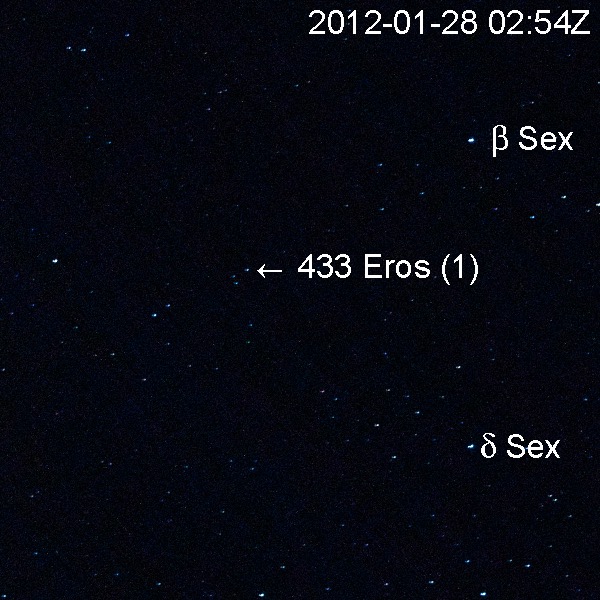Visual and photographic observations of Near Earth Asteroid 433 Eros
Has anyone else been viewing or photographing Eros during its current close approach? I found it in Leo the other night using 7x50 binoculars in less-than-perfect skies. Over three hours, I could definitely detect motion against the stars. I could see mag 4.5 stars unaided and mag 9 stars in the binos, so the mag 8.5 asteroid was just visible.
Note to software users: make sure you update the orbital elements if making your own finder charts!
Last night I confirmed my identification of Eros, as it had moved south in declination by more than a degree. The nearest named star is 35 Sex.
I would love to hear from others observing Eros.
Note added 2012-01-25: Still following Eros through Sextans in mildly light-polluted skies. SQM reading is 20.5 on good nights. I wonder how the Moon will affect things?
Note added 2012-02-04: On 2012 January 27/28 I took several wide-field astrophotos of the Sextans region with my Canon XSi on the MusicBox EQ mount with the Canon 17–85 zoom lens set at 85 mm f/5.6 with ISO 800 for 30s, hoping to record Eros. I processed the photos a little and annotated them, and the results are in the gallery [formerly stored at Apple's MobileMe] below.
The bright stars Alpha and Beta Sextantis are a little over 2 degrees (120') apart, and the photos are (roughly) oriented with north up.
One can see the motion of Eros over 4 hours by toggling back and forth.
Note added 2012-02-15: Dave Lane took some images on 2012-02-08 from his observatory near Halifax. The processed positions were plotted and uploaded to the Eros Parallax Project. The data are viewable at https://www.flickr.com/photos/transitofvenus2012/
 |
 |
| Attachment | Size |
|---|---|
| 114.7 KB | |
| 137.5 KB |
- dave.chapman@ns.sympatico.ca's blog
- Log in to post comments

Comments
ASTEROID
THANK FOR NEW INFORMATION I LIKE ASTEROID AND NEW DESCOVERY